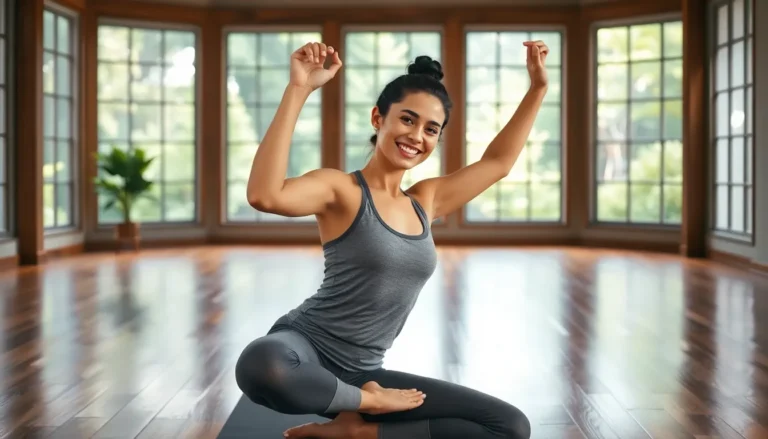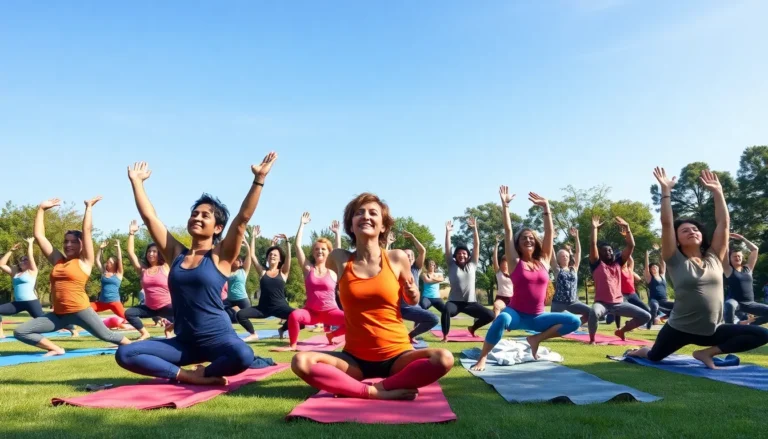Table of Contents
ToggleLooking to get fit without the hassle of a gym membership? Calisthenics might just be your new best friend. It’s like a bodyweight party where everyone’s invited, and the only requirement is that you show up ready to move. No fancy equipment needed—just you and the great outdoors or even your living room floor.
Overview of Calisthenics Routine
Calisthenics routines focus on bodyweight exercises designed to enhance strength, flexibility, and endurance. These workouts incorporate movements like push-ups, pull-ups, squats, and lunges, targeting multiple muscle groups without the need for weights or machines. Practitioners perform these exercises in various sequences, allowing for tailored workouts that match fitness levels.
A typical calisthenics routine often starts with a warm-up, which prepares the body for more intense activity. Following the warm-up, participants engage in higher-intensity exercises that elevate heart rates and build muscle strength. For example, circuits may include three to five rounds of different exercises, ensuring a comprehensive workout.
Structured routines can vary based on goals. Beginners generally focus on fundamental movements, while advanced individuals might explore more complex variations like muscle-ups and planches. Progression techniques such as adding repetitions or decreasing rest times enhance challenges further.
Customization plays a crucial role. Routines allow individuals to modify exercises based on personal fitness levels and preferences, empowering them to work at their own pace. This adaptability encourages ongoing engagement and motivation.
Calisthenics also integrates rest days for recovery. Sufficient recovery time helps muscles repair and grow stronger, ultimately improving performance. Nutrition alongside consistent training significantly contributes to achieving fitness goals.
Overall, calisthenics offers a versatile approach to fitness. It’s suitable for various environments, from parks to living rooms, making it accessible and effective for all fitness enthusiasts.
Benefits of Calisthenics

Calisthenics offers numerous benefits for both the body and mind, enhancing overall fitness without the need for equipment.
Physical Benefits
Building strength is one of the primary outcomes of calisthenics. It targets multiple muscle groups through compound movements like push-ups and squats. Improving flexibility comes naturally, as these exercises often involve dynamic stretching. Enhancing endurance is achievable with high-repetition circuits that elevate heart rates. Calisthenics promotes better posture by strengthening core muscles, which is essential for overall stability. Favoring injury prevention, it encourages functional movements that mimic daily activities. Accessible for individuals at all fitness levels, calisthenics routines adapt easily to personal goals and progress over time.
Mental Benefits
Strengthening mental resilience occurs alongside physical training in calisthenics. Developing a sense of accomplishment from mastering bodyweight exercises enhances motivation. Boosting mental clarity happens as regular workouts stimulate endorphin production. Stress reduction also results from engaging in a structured routine, aiding in emotional balance. Cultivating discipline becomes easier with consistent practice, fostering a commitment to fitness goals. Furthermore, calisthenics nurtures a sense of community through group workouts or online support, contributing to enhanced social well-being.
Essential Equipment for Calisthenics
Calisthenics emphasizes its accessibility, requiring minimal equipment. Effective routines often utilize bodyweight to enhance strength and flexibility.
Bodyweight Exercises
Bodyweight exercises form the core of calisthenics routines. These movements engage various muscle groups, promoting functional strength. Popular exercises include push-ups, pull-ups, squats, and lunges, each delivering significant fitness benefits. Variations increase intensity and challenge, allowing for skill progression. Advanced practitioners might explore planches or muscle-ups to push their limits. Regardless of skill level, bodyweight exercises can adapt to individual needs, ensuring everyone can participate.
Optional Gear
While calisthenics relies heavily on bodyweight, optional gear enhances workouts. A sturdy pull-up bar enables various upper body exercises, enhancing strength further. Resistance bands offer assistance or added resistance, increasing workout variability. Gymnastic rings create unique challenges, improving stability and control during movements. A yoga mat provides comfort during floor exercises, aiding in proper form. Each piece of gear can elevate the workout experience, catering to different fitness goals.
Sample Calisthenics Routine
A structured calisthenics routine enhances fitness while promoting strength, flexibility, and endurance. Here are examples tailored to different experience levels.
Beginner Routine
Start with a warm-up to prepare muscles. Perform 3 sets of 5-10 push-ups, followed by 3 sets of 5-10 bodyweight squats. Include 3 sets of 3-5 lunges per leg. Add 2-3 sets of 5-8 wall sits, holding for 20-30 seconds. Finally, finish with 10-15 minutes of light stretching. This routine builds foundational strength and promotes proper movement patterns.
Advanced Routine
Begin with 5-10 minutes of dynamic stretching. Transition to 4-5 sets of 10-15 pull-ups, if accessible. Include 4 sets of 15-20 push-ups, opting for variations like decline or archer push-ups. Incorporate 4 sets of 10-15 pistol squats per leg, advancing to 3-5 sets of 8-10 muscle-ups. Cap off the workout with 15-20 minutes of high-intensity interval training. This advanced routine challenges strength and endurance, pushing limits effectively.
Tips for Success in Calisthenics
Calisthenics success hinges on a few key factors. Prioritizing consistency and gradual progression sets a solid foundation.
Consistency and Progression
A consistent routine fosters steady improvement. Beginners should aim for three to four workouts per week, gradually increasing frequency over time. Progression comes through challenging the body with more complex exercises or increased repetitions. Incorporating variations, such as changing grip in push-ups or adding explosive movements, enhances adaptability. Tracking workouts helps maintain motivation and celebrate achievements. Setting measurable goals provides focus, making the journey rewarding.
Nutrition and Recovery
Proper nutrition plays a vital role in fitness outcomes. Consuming a balanced diet rich in protein, carbohydrates, and healthy fats supports muscle growth and recovery. Staying hydrated is equally crucial for overall performance. Rest days, while often overlooked, allow muscles to repair and strengthen. Integrating active recovery through light activities, such as walking or stretching, can also benefit overall performance. Quality sleep enhances recovery, energy levels, and mental focus, reinforcing the importance of a holistic approach to fitness.
Calisthenics offers a dynamic and accessible way to enhance fitness without the need for a gym. With its focus on bodyweight exercises, individuals can build strength, flexibility, and endurance in any environment. The ability to customize routines ensures that everyone can find a suitable challenge while progressing at their own pace.
Incorporating calisthenics into a fitness regimen not only promotes physical health but also fosters mental resilience and community connection. By prioritizing consistency, nutrition, and recovery, practitioners can maximize their results and enjoy a holistic approach to well-being. Embracing calisthenics is a step toward achieving personal fitness goals and cultivating a healthier lifestyle.







